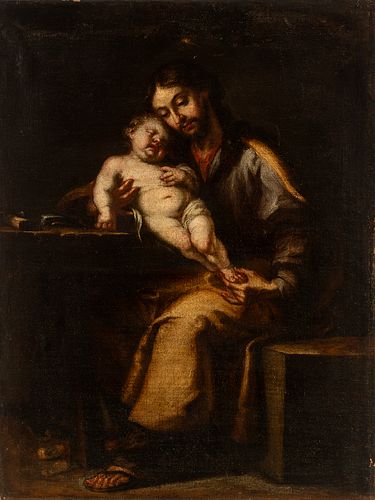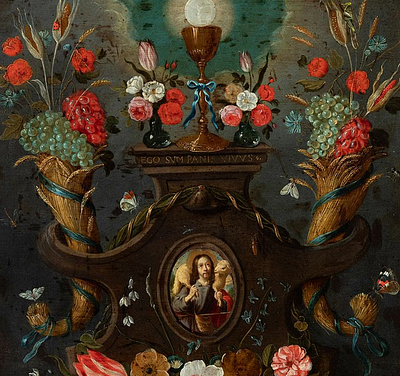PEDRO ANASTASIO BOCANEGRA (Granada, 1638 - 1689) "San José with Child". Oil on canvas. Relined. It presents repainting and air bubble in the re-ent
Lot 6
About Seller
Setdart Auction House
Carrer Aragó 346
Barcelona
Spain
Setdart Subastas was born in 2004 and is currently the first online art auction in Spain with solidity, prestige and reliability guaranteed by our more than 60,000 users. Setdart has a young, dynamic and enterprising team ready to successfully manage the purchase and sale of art works through custom...Read more
Estimate:
EUR€4,000 - EUR€5,000
$4,166.67 - $5,208.33
Absentee vs Live bid
Two ways to bid:
- Leave a max absentee bid and the platform will bid on your behalf up to your maximum bid during the live auction.
- Bid live during the auction and your bids will be submitted real-time to the auctioneer.
Bid Increments
| Price | Bid Increment |
|---|---|
| EUR€0 | EUR€10 |
| EUR€200 | EUR€25 |
| EUR€500 | EUR€50 |
| EUR€1,000 | EUR€100 |
| EUR€3,000 | EUR€200 |
| EUR€5,000 | EUR€500 |
| EUR€10,000 | EUR€1,000 |
| EUR€20,000 | EUR€2,000 |
| EUR€50,000 | EUR€5,000 |
About Auction
By Setdart Auction House
Sep 21, 2021
Set Reminder
2021-09-21 10:00:00
2021-09-21 10:00:00
America/New_York
Bidsquare
Bidsquare : 21st September - ARAS JÁUREGUI Private Collection - Old Masters, 19th & 20th Century
https://www.bidsquare.com/auctions/setdart-auction-house/21st-september---aras-j-uregui-private-collection---old-masters-19th-20th-century-7429
Setdart Auction House sofia@setdart.com
Setdart Auction House sofia@setdart.com
- Lot Description
PEDRO ANASTASIO BOCANEGRA (Granada, 1638 - 1689) "San José with Child". Oil on canvas. Relined. It presents repainting and air bubble in the re-entellation. Measurements: 102 x 77 cm. In the centre of the scene, the figure of the sleeping Infant Jesus stands out for its rounded and dazzling flesh, as the body of the Child radiates the only light of the scene. In a slightly strained posture, Jesus rests leaning on the table and on his father, as his little feet rest on Joseph's knees. Joseph gazes at his proud, inebriated son, holding one of the little feet with one of his hands in an affectionate and close attitude. Both figures are shown to the viewer in an intimate manner, set against a neutral background with few details. These allude to Joseph's profession, such as the work table, the tools and the remains of the wood carving that have fallen to the ground. Until the Counter-Reformation, the figure of St. Joseph was usually relegated to the background, as no theological importance was attached to him. After the Council of Trent, however, his leading role as the protector of Jesus during his childhood and as a guide during his youth was restored, and he is depicted here as such. In contrast to the tenderness, defencelessness and candour of the infant figure, Saint Joseph is presented as a monumental figure. Through this form of representation, the author visually emphasises the decisive role of Jesus' putative father as protector. From its style, we can relate this image to the hand of Pedro Atanasio de Bocanegra, a painter from Granada who was a disciple of Alonso Cano, Pedro Moya and Juan de Sevilla, the most active artist in Granada in the 1660s. His first known work was the decorations for the Corpus Christi festivities in his native city in 1661. During the following years we find commissions such as the series of canvases he executed between 1665 and 1666 for the cloister of the convent of Nuestra Señora de Gracia, now lost; or the numerous paintings, including the "Conversion of Saint Paul", which he painted between 1668 and 1672 for the altar of the college of the Society of Jesus, now the church of Saints Justo and Pastor (in situ). At the same time he was commissioned to decorate the Carthusian monastery in Granada with large scenes from the life of the Virgin. He was also appointed painter to the cathedral. After this period he went to Seville in 1686, and from there he left for the court of Madrid, where he was protected by Don Pedro de Toledo, Marquis of Mancera. Thanks to the influence of his protector, Bocanegra was awarded the title of painter to the king "ad honorem" for his painting "Allegory of Justice", inspired by a mid-16th-century Venetian print and now in the Royal Academy of San Fernando. After his stay in Madrid, Pedro Bocanegra returned to Granada. In addition to the aforementioned art galleries and religious centres, works by this master can now be found in the Zaragoza Museum, the Goya Museum in Castres, the Diocesan Museum of Sacred Art in Vitoria and the Fine Arts Museum in Granada, as well as in various private collections.
- Shipping Info
-
In-house shipping available. Please inquire at admin@setdart.com.
-
- Buyer's Premium



 EUR
EUR CAD
CAD AUD
AUD GBP
GBP MXN
MXN HKD
HKD CNY
CNY MYR
MYR SEK
SEK SGD
SGD CHF
CHF THB
THB

















